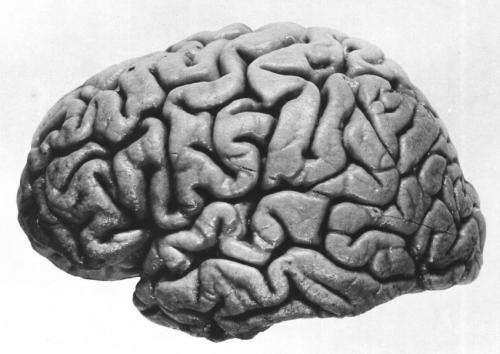Left hemisphere of J. Piłsudski's brain, lateral view. Credit: public domain
A new study conducted by a researcher at the George Washington University suggests that the right hemisphere of the brain may be able to assist a damaged left hemisphere in protecting visual attention after a stroke.
Summer Sheremata, a postdoctoral research fellow in the Attention and Cognition Laboratory in the Columbian College of Arts and Sciences, led the study. The paper, "Hemisphere-Dependent Attentional Modulation of Human Parietal Visual Field Representations," was published in the Journal of Neuroscience in January.
"Patients with damage to the right hemisphere often fail to visually perceive objects on their left, but the reverse is much less common. That is, damage to the left hemisphere does not typically lead to deficits in attention," Dr. Sheremata said. "Psychologists have hypothesized that the right hemisphere could help out the left hemisphere in attending to objects on the right, both in healthy individuals and patients recovering from stroke, but until now it remained an assumption."
The research was conducted at the University of California, Berkeley, with senior author Michael Silver, associate professor of optometry and vision science and neuroscience. Participants' brain activity was measured using fMRI while they used their attention in two different ways:
- Paying attention to a central box, ignoring a moving object in the background, and
- Ignoring the central box and paying attention to the moving object in the background.
The first scenario measures the visual response, confirming that the right side of the brain represents the left visual field and that the left side of the brain represents the right visual field. The second scenario tests the effects of visual attention and indicates that while the left side of the brain only focused on the right visual field, the right side of the brain was able to represent both sides of the visual field. Visual field representations are included in a figure in the study.
While the research was conducted on healthy, non-stroke patients, the results suggest a possible brain mechanism for how the visual field can be recovered if it is damaged by a stroke.
"The results demonstrate that the tasks we do every day change how the brain pays attention to the world around us. By understanding how these changes occur in healthy individuals, we can focus on behaviors that are impaired in stroke patients and provide a focus for rehabilitation," Dr. Sheremata said.
To further the research, Dr. Sheremata plans to study how these effects influence behavior in stroke patients and healthy individuals during attention and memory. Her next round of studies is being conducted at the George Washington University.
More information: "Hemisphere-Dependent Attentional Modulation of Human Parietal Visual Field Representations." Journal of Neuroscience, 14 January 2015, 35(2):508-517; www.jneurosci.org/content/35/2/508.full.html
Journal information: Journal of Neuroscience
Provided by George Washington University





















